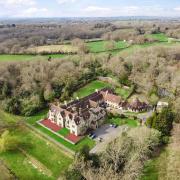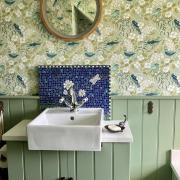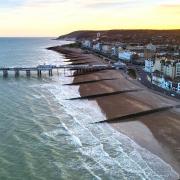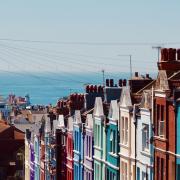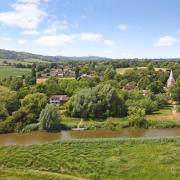Kaffe Fassett is to patchwork and knitting what rainbows are to dull and dreary days. He exploded onto the textiles scene in the late 1960s like Joseph’s amazing technicolor dreamcoat and has been showering handicrafters with a kaleidoscope of many colours ever since.
Equally celebrated for his love of riotous pattern, he took a pinch of Flower Power, a dash of ‘the Beatles hippy thing’ and mixed it with a smidge of the experimental Portobello Road.
He’s 86 now, but still in huge demand. When we speak, he has just returned from a talk in Bath and is packing his bags for Stockholm. Kaffe is also publicising the landmark 25th book in his patchwork and quilt series, this time celebrating the ‘nostalgic mix of heightened, vulgar colour and pastel tones’ of Hastings, where he has a weekend retreat. He moved to the seaside town in 2001, plumping for an imposing Victorian villa high on a hill in the old town.

Down At Heel
‘I love Hastings,’ he says. ‘It isn’t chi chi and commercialised like Brighton. I also like the fact that it’s a bit down at heel. There are still crusty old boats and great tumbledown houses painted in sky blue, rust pink and yellow. And I adore those big, black witches’ huts where the fishermen dried their nets, which might have come straight out of a scene from David Copperfield.’
Kaffe was introduced to Sussex by the film director John Schlesinger. Years later, he and his partner, Brandon Mably, were fruitlessly looking for an affordable second home when Kaffe remembered his many visits to Schlesinger’s home in Rye, which he’d found ‘very charming’.
They bought a cottage there, but Kaffe began to find the cinque port ‘too precious’ and started casting around for a more Bohemian stamping ground. He was drawn to Hastings because of the ‘gypsy-like’ way the residents painted their terraced houses in bold, clashing colours.
‘I liked the fact that the people there were unashamedly their own person and painted their own colour combinations on their houses,’ he says. “Since then the town has become a lot more beige. Everything is in such good taste and a lot more grown up. It was childlike and fun in the old days.’

Quilts by the Hastings Sea
Nevertheless, he still finds plenty to inspire him, evidenced in his new book, Quilts by the Sea, which features patchwork designs inspired by the local topography, as well as vibrant location photography by long-time collaborator Debbie Patterson. His quilts are photographed pinned to eye-popping beach huts, draped like brightly coloured washing over the sides of barnacled boats and even suspended like psychedelic windbreaks across the rusting underpinnings of Hastings Pier.
He has always been drawn to old seaside towns and says Hastings has a particularly good mix of ‘the fun and the faded’ that makes it the perfect showcase for his designs.
‘Rows of jauntily painted beach huts are just the right dolls-house size to suit my quilts, along with the old boats on the beach with their distressed, rusty charm, and the splendid pier with its funfair and its silvered wood,’ he says.
‘The particular light that seems unique to this seaside town similarly never fails to lift my spirits as I stroll through the old town or along the shoreline. Many of my designs reflect the dark, rich colours of Hastings but I had just as much fun with the high pastel tones of the lighter seaside palette.’
Californian by birth, Kaffe moved to London in 1964 and started out as a painter. His Damascene moment came in 1968 when the fashion designer Bill Gibb took him to a Scottish woollen mill. Kaffe was blown away by the subtlety and richness of the old tartans there, which echoed the natural hues of the landscape, so he snapped up 20 Shetland yarns and asked a fellow rail passenger for an impromptu knitting lesson on his way home.
His first sweater design was a complete mess, he says, but Vogue Knitting commissioned him to design a Fairisle cardigan on the strength of his flair for colour alone. Vogue then asked him to design a long, woollen coat, which caught the eye of Missoni, the Italian fashion house famed for its unique and colourful knitwear.
It was a marriage made in heaven and he designed many one-off designs for them which were modelled by the likes of Barbra Streisand, Shirley MacLaine and Lauren Bacall. But it is through his lectures, talks and how-to books that he has proved most influential.

Knitting King
Kaffe’s first book, Glorious Knitting, became a set text for every aspiring knitter in 1985. His six-part Channel 4 series, Glorious Colour, has been repeated three times since its first airing in 1988. And that same year he doubled attendance figures at the Victoria and Albert Museum when he became the first living textile artist to stage a one-man show there. In 2013 his reputation was cemented with a follow-up exhibition at the Fashion and Textile Museum in London.
It’s hard to understate his revolutionary approach to the staid and traditional world of knitting when he first burst onto the handicraft scene. ‘You had little sweaters with a white yoke and some details knitted into it, but that was the only Fairisle pattern around,’ he says. ‘In contrast, I was looking at the wonderful patterns to be found in museums, the things you could see in the old world, as well as tiles, mosaics and old Chinese artefacts, and putting them all into knitting.
‘I got everybody excited. And then, suddenly, out of the woodwork, came other knitters like Sasha Kagan and the founders of Toast, Jamie and Jessica Seaton, and all of us were suddenly doing these patterned knitting designs that caught people’s imagination.’
While crafters went crazy for his patterns, he claims he was overlooked by the British art establishment for decades. ‘I had to educate the world that it was worth their snooty time to have a look at textiles. But it took a long time for them to realise there’s as much poetry and depth of perception to be had through colour and pattern as there is through watching a Shakespeare play. For years, what I did was just considered “happy hands at home”.’

Royal Knitter
This view appears to have been shared by the late Queen who was introduced to Kaffe at a reception at the American Embassy in London for ‘all the American big achievers in town’.
‘She sailed in and went round to talk to all of us,’ he recalls. ‘I was introduced with the words, “Ma’am, this man has had an exhibition at the V&A.” She said, “Oh yes, what of?” And I said, “Knitting.” “Knitting?” she frowned. “Why, I can do that,” and just turned on her heel.’
These days, he works almost exclusively in patchwork, designing patterns for patchwork fabrics and creating patchwork designs for quilts. ‘Ideas come from the darndest places. I once did a book based on the geometry you find on drainage systems and manhole covers.’
His latest book showcases 21 designs, each cherry picked from one of his previous books, and revived or reinvented with up-to-date fabrics. ‘I’ve always been fascinated by how colour can transform a print or quilt layout so it becomes quite unrecognisable,’ he says. ‘Sometimes I chose favourites from a particular book, but at other times it was exciting to rejig a quilt that hadn’t been such a success to see if different colours and fabrics would breathe new life into the design.’
Kaffe may be still travelling the world as he approaches 90, but one suspects he owes at least some of his undiminished enthusiasm to his husband, studio manager and fellow designer, Brandon, who quietly manages his life in the background. ‘He plans everything and then we face the world and give lectures together,’ he says.

They met at a bus stop in north London. ‘Brandon said, “What do you do?”And I said, “I live around the corner. Come round and look through the window and you’ll see the things that I’m working on.”
‘He came straight over, knocked on the door – he wasn’t going to just look in the window – and immediately understood what was going on. He had no art education, but he just absorbed it all. He had this amazing intelligence.’
Over the past 30 years, they have transformed their main home, in Kilburn, into four floors of freewheeling colour. Barely a corner is untouched by a Fassett print or textile. Armchairs are upholstered with vibrant needlepoints, walls hung with bold tapestries or hand painted wallpapers, and surfaces littered with Chinese ceramics. It’s like William Morris on steroids.
After Kaffe’s day, the house will become a museum. ‘Visitors will be able to see my archive, my sketchbooks and everything else I have created for this house,’ he says.
In the meantime, you can create your own little piece of Kaffe Fassett magic by replicating his quilt designs at home. Failing that, you could take up knitting. Well, if it’s good enough for the late Queen...
• Kaffe Fassett’s Quilts by the Sea by Kaffe Fassett is out now (Taunton Press, £30); kaffefassett.com.



















